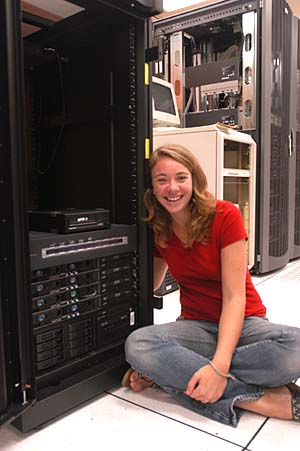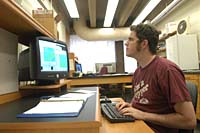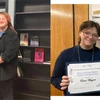|
|
Computer models that simulate what happens in real life have become important tools in managing ecological problems and discovering ways to avoid worst-case scenarios. Sherri Mason (chemistry) has funding from the Great Lakes Commission to improve and validate an atmospheric model that will predict the movement of pollutants coming into the air from cars, industry, and even Great Lakes evaporation.
With a research grant of $80,000 through the Great Lakes Air Deposition (GLAD) program, she is collaborating with the New York State Department of Environmental Conservation to model the locations of chemicals in the air that are known to be carcinogenic or hazardous to humans.
“Scientists have already done well at modeling ozone and carbon monoxide air pollution,” Dr. Mason said, “But in this project we’re hoping to move into the next phase. We want to accurately model the movement and deposition of particulate matter --like dust.” She pointed out that it is not only the dust itself, but also what collects on the dust that has people concerned.
The Agency for Toxic Substances and Disease Registry lists 100 chemicals (so far) that collect on dust particles after being emitted from cars or industrial sites. Each one of them is toxic. Mercury is one such compound, which is of heightened environmental interest as it can evaporate into the air from surface water. “After being released and deposited into the lakes, a lot of pollutants get re-released back into the air,” Dr. Mason said, “Understanding this type of cycling of pollutants through the environment is key to understanding the impacts of humans on the global scale.”
The trust people put in computer simulations, like the one Dr. Mason is working with, depends on the validity of the model, making verification and validation crucial. Restricting her focus to an area of New York State, Dr. Mason is validating the model using data collected in 2002 from air samples taken by scientists on another GLAD research project, one of whom was Fredonia professor Mike Milligan (chemistry).
“Mike and the Clarkson University group collected a really nice data set with which to do a model comparison,” Dr. Mason said. “Our research proposal was to apply the model to a three-month period in 2002, when Mike and his group were taking air quality measurements in a certain area. Our hope is that the model predicts the results they obtained in the field.”
|
|
“Reg,” which is short for Regional Atmospheric Model, is what Dr. Mason calls her Linux cluster. “Yes,” she said. “I’m that much of a nerd.”





